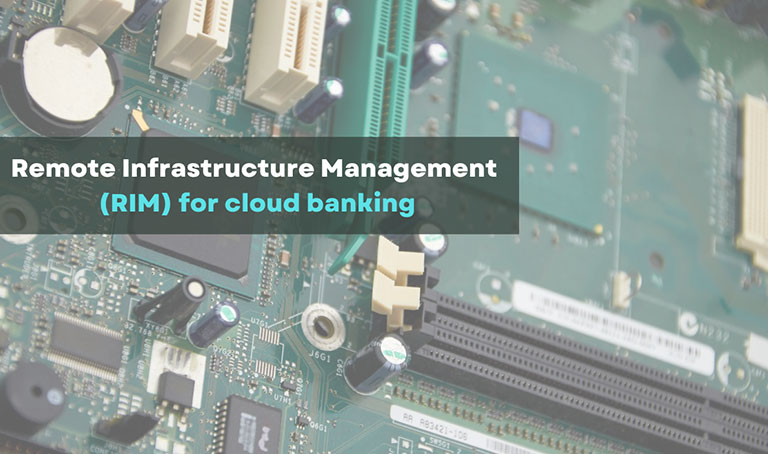Remote Infrastructure Management (RIM) for Cloud Banking
Updated On : May 2022
While IT infrastructure costs are increasing, there is a rise in IT infra maintenance costs and spending on higher budgets for expanding IT teams. Reducing IT spending is crucial and banks are aiming to streamline operations and reduce their outlay on IT infra management by opting for RIM (Remote Infrastructure Management). RIM can significantly cut down IT expenditures and enable faster, more flexible service.
Next-gen Remote Infrastructure Management (RIM) services are steadily increasing with over 85% of infrastructure components being managed from remote locations. The $524 billion infrastructure management industry moving towards a remote, distributed, and dynamic IT environment with the clear benefits of lower costs and no risk of failure.
Research has indicated that advanced digital technologies properly implemented in RIM can help businesses save 25% of spending in the total infrastructure budget. RIM is changing the landscape by providing better processes, products, people, and set-ups that bring in great business value in the dynamic IT landscape.
With the banking industry adopting digital with the rapidly changing IT landscape, banks and financial institutions are leveraging cloud applications. The cloud’s benefits of agility, speed, and nimbleness are gained with new-age applications built on remote delivery models.
IT admins are always looking out for remote IT infrastructure tools to help them manage cloud infrastructure through the software lifecycle, and are choosing from a range of newly launched tools that enable true remote management of cloud infrastructure.
In 2020, Covid19’s unprecedented appearance made remote working or work from home, a reality. Soon, there was a seismic shift to remote working for all industries including the finance industry. This was possible because of cloud services and a huge number of cloud-based SaaS solutions. Being able to connect from anywhere has become the biggest advantage for business continuity.
However, the high demand for RIM coincided with the increasing complexity of managing cloud infrastructure. Applications have been globally dispersed in multi-cloud environments which have complicated IT infrastructure with the demands of cloud infrastructure management. In response, there has been a rollout of new IT solutions for remote workforces, which assured that IT ops teams can deploy, predict, upgrade, and troubleshoot cloud software from anywhere. The new capabilities offer a seamless experience from anywhere and a more secure and resilient IT infrastructure whether it is from home or a remote location.
During the Covid 19 pandemic, the US had two-thirds of its employees working remotely and there was immense pressure on the IT operations teams which had to manage their IT infrastructure. Since it was necessary to centrally monitor and maintain the infrastructure from remote locations, it was RIM that took care and offered important benefits like -
- Round the clock support
- Real-time error identification
- Lower operational costs
- Improved productivity
- Efficiency
- Flexibility
With RIM Server Service for cloud banking, banks and financial institutions improve the efficiency of their support systems and can focus on their primary business. The management of the server infrastructure including both hardware and operating system is taken care, of round the clock throughout the year. Whether it is monitoring the server infrastructure and reporting, performing user, password, and backup administration, RIM handles everything remotely & efficiently. With Infrastructure as Code, even updation of the operating system to maintain security and high performance and reduce potential service disruptions is now a routine RIM activity.
Some of the advantages RIM offers over traditional infrastructure management solutions are:
- Improvement of processes
- Flexible and faster service
- Lower risk of IT failure
- 30% operational costs reduction
- Low up-front investment
- consistent performance of business-critical servers
- Performance tracking through detailed reporting and insight
- Updating of infrastructure with timely releases and patches
- Improved IT governance with controlled and authorized changes
Banks can benefit immensely from a zero-touch deployment from a remote site where the cloud infrastructure deployment is automated and centralized at scale. The tracking and insights in the development phase also provide predictive health and intelligent support services to streamline IT tasks. It scans data from the cloud deployment and picks up issues that could pose a risk to the performance of the application and data availability. Thereafter, it is easy for system engineers to fix issues remotely using customized recommendations. Customers can also automatically seek a support ticket to get issues resolved by a Site Reliability Engineer (SRE).
An upgraded infrastructure has become a very critical requirement to create a secure cloud environment and build employee efficiency. Adopting RIM can help banks and financial institutions to focus on their core operations and serve customers better, unhindered by worries of managing an expanding infrastructure.


Comments :